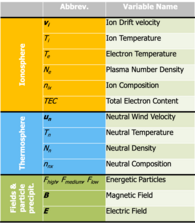Diese Seite ist zur Zeit leider nur in englischer Sprache verfügbar.
The Daedalus mission has been proposed to the European Space Agency (ESA) in response to the call for ideas for the Earth Observation programme's 10th Earth Explorer. It was selected in 2018 as one of three candidates for a Phase-0 feasibility study.
The goal of the mission is to quantify the key electrodynamics processes that determine the energetics, dynamics and chemistry of the upper atmosphere, “gateway” between the Earth’s atmosphere and space. The mission design shall allow Daedalus to break through the current spacecraft exploration “barrier” of 150 km and access electrodynamics processes at lower altitudes.
An innovative preliminary mission design allows Daedalus to access electrodynamics processes down to altitudes of 150 km and below. Daedalus will perform in-situ measurements of plasma density and temperature, ion drift, neutral density and wind, ion and neutral composition, electric and magnetic fields and precipitating particles. These measurements will unambiguously quantify the amount of energy deposited in the upper atmosphere during active and quiet geomagnetic times via Joule heating and energetic particle precipitation, estimates of which currently vary by orders of magnitude between models.
Another innovation of the Daedalus preliminary mission concept is that it includes the release of sub-satellites at low altitudes: combined with the main spacecraft, these sub-satellites will provide multi-point measurements throughout the Lower Thermosphere-Ionosphere region, down to altitudes below 120 km, in the heart of the most under-explored region in the Earth's atmosphere.
Daedalus orbit (animations): "Where Neutral Atmosphere Meets Electromagnetic Forcing”
Laufzeit
Sep 2019 – Feb 2021
Zuwendungsgeber
European Space Agency (ESA)
ProjektmitarbeiterInnen
- Dr. Guram Kervalishvili (GFZ team leader)
- Prof. Dr. Claudia Stolle (GFZ)
Projektwebseite
Kooperationen
- The Proposing Team submitted the concept of this mission to ESA's Earth Explorer 10 call
- The Mission Advisory Group provides expert advice to ESA during mission design and development
- The Science Study Team defines scientific objectives and related measurement requirements
Publikationen
- Sarris, T. E., Talaat, E. R., Palmroth, M., Dandouras, I., Armandillo, E., Kervalishvili, G., Buchert, S., Tourgaidis, S., Malaspina, D. M., Jaynes, A. N., Paschalidis, N., Sample, J., Halekas, J., Doornbos, E., Lappas, V., Moretto Jørgensen, T., Stolle, C., Clilverd, M., Wu, Q., Sandberg, I., Pirnaris, P., and Aikio, A. (2020), Daedalus: a low-flying spacecraft for in situ exploration of the lower thermosphere–ionosphere, Geosci. Instrum. Method. Data Syst., 9, 153–191, doi: 10.5194/gi-9-153-2020.


![[Translate to English:] https://doi.org/10.5194/gi-2019-3 © Author(s) 2019. This work is distributed under the Creative Commons Attribution 4.0 License.](/fileadmin/_processed_/e/3/csm_Daedalus_EE10_Proposal_subm_2_ToC_01_803b597443.png)

